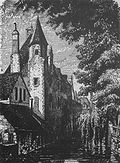Louis Lambert is a French novel by Honoré de Balzac (1799–1850), included in the Études philosophiques section of his novel sequence La Comédie humaine. Set primarily in a school at Vendôme, it examines the life and theories of a boy genius fascinated by the Swedish philosopher Emanuel Swedenborg (1688–1772). Balzac wrote Louis Lambert during the summer of 1832 while he was staying with friends at the Château de Saché. The novel contains a minimal plot, focusing mostly on the metaphysical ideas of its boy-genius protagonist and his only friend (eventually revealed to be Balzac himself). Although it is not a significant example of the realist style for which Balzac became famous, the novel provides insight into the author's own childhood. Specific details and events from the author's life – including punishment from teachers and social ostracism – suggest a fictionalized autobiography. Critics panned the novel, but Balzac believed that it provided an important look at philosophy, especially metaphysics. As he developed the scheme for La Comédie humaine, he placed Louis Lambert in the Études philosophiques section, and later returned to the same themes in his novel Séraphîta, about an androgynous angelic creature.
